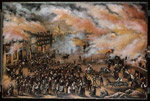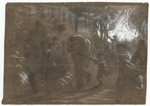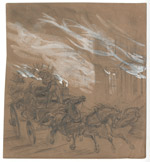The Eyewitnesses
I write this from memory, after the lapse of over eight years. But the events of that memorable night were so burned into my mind and heart that they are seemingly as fresh and vivid today as when they were occurring.
Fire Narrative of James O. Brayman
The Great Chicago Fire first entered the web of memory through the senses of those who experienced it first-hand--who gaped at its brilliance, choked on its smoke, shuddered at its roar, and recoiled from its heat. No matter how stunned they were, they knew at the time that they were unwilling participants in the most critical moment in their young city's hurried history of continuous transformation. "[T]he world as it is to people of this vicinity, has changed," one resident wrote five days after the disaster, "an age has closed, and a new epoch, obscured in doubt and uncertainty, is about to begin." A day later another Chicagoan told his family, "Everything will date from the great fire now."
The eyewitnesses soon collected their thoughts and communicated them to others as best they could. As H. A. Musham, author of the first carefully documented account of the fire (which did not appear until almost seventy years afterwards), observed, "Every one of the 334,270 people in Chicago on those fateful days had a story to tell, and they never tired of telling it." They told and retold their stories because the fire was the most remarkable thing that had ever happened to them, and because talking about it was the best means available to try to deal with its terror and magnificence. And many eyewitnesses, some as late as the 1940s, wrote their recollections down. They did so not only because of their own recognition of the importance of the occasion or at the prompting of relatives and friends, but also because there was a continuing demand for their remembrances from the world at large. Newspapers and magazines sought out first-person accounts to include prominently in their pages. In addition, the Chicago Historical Society solicited fire narratives from survivors, so that its collections now contain about two hundred of them. Over the years several anthologies of letters and recollections have appeared, the most recent in 1979.
Eyewitness accounts of the fire make compelling reading on several levels. They appeal, first of all, to an insatiable interest in the spectacle and drama of urban catastrophe, especially this stupendous fire that struck down a city that many took to be the emblem of urbanizing America. At the same time, however, the narratives are engaging because they put this titanic cataclysm in human terms, offering a way to understand it on a personal level and a comprehensible scale. These accounts possess, furthermore, a quality of authenticity and immediacy that no second-hand description can provide.
But the eyewitness narratives also have inherent limitations. The fire was so enormous and overwhelming that no one person could witness it, let alone accurately recall it, in its entirety. "It was too vast, too swift, too full of smoke, too full of danger, for anybody to see it all," Chicago Tribune editor Horace White recalled in his own fire narrative. In addition, the mass of memories do not cohere into anything approaching a consistent story. Having read dozens of descriptions of the fire in his scrupulous search for the facts, Musham confessed, with some exasperation, "The accounts disagree almost unanimously as to details." To complicate things further, narratives written close to the event were colored by the understandably shifting moods of a traumatized populace looking for a silver lining but vulnerable to pessimism and rumor, while the ones penned later were inflected by the writer having seen or heard other stories and by the inevitable fading of memory.
There is another intriguing aspect to the fire narratives, one that they share with the journalism and histories of the fire. This aspect is summed up in Horace White's observation that the conflagration "was simply indescribable in its terrible grandeur." Account after account includes a statement of this kind. Even though it is always followed by an attempt to describe that same terrible grandeur, more was involved here than a rhetorical flourish. The assertion that what was witnessed could not be faithfully translated into language, that the narrative will inevitably fall short of the actual event, was unquestionably sincere.
There are certain other things to keep in mind in considering the narratives. The particular circumstances of different individuals not only shaped what they wrote, but whether they wrote at all, and for whom. The available narratives were mostly prepared by native-born residents and visitors of some means and education, which leaves out a very substantial portion of the city's population. Such people generally had greater means and opportunity to record their reflections than did the poorer and less literate, and it was more likely that what they wrote would be preserved. It is also very possible that there are many narratives written by foreign-born residents that are not available because they were sent to relatives in Europe and never made it back to this country. One narrative that did return to Chicago, by William A. Wieboldt, is included in the Library for this section. There is, nevertheless, some variety among the accounts, depending on the author's gender, neighborhood, and how directly he or she was affected by the fire. Another important variable that shaped the accounts is the age of the author in 1871. Several especially engaging narratives were written either by children or by adults who were children at the time of the fire.
What can the reader take away from these accounts? Quite a bit, even if it is not the coherent, comprehensive, and reliable information about the nature and progress of the fire that Musham was seeking. Although people experienced more than they could ever remember, and what they did write down was only a fraction of what they could recollect, the fire narratives still eloquently reveal how Chicagoans perceived their world in this moment of destruction. They show how their authors made sense of the trauma of the fire, how they explained and integrated it into their understanding of their lives and that of their city. Given the horrific nature of what the accounts describe, many of them seem surprisingly understated, especially in comparison with the sensationalism in the work of professional writers playing to a mass audience. Their measured record of the confrontation with acute distress and severe loss possesses a deeply moving quality.
While the personal accounts do vary a great deal on particulars, they generally follow a similar sequence: the first news of the fire and early confidence that it will be contained; the author or a relative (usually the men of the house) heading toward to a place from which they can view the blaze and, in several instances, checking on the condition of a downtown office; the realization that no one is safe, followed by the frantic gathering of family and goods in preparation for flight; the retreat (often in several stages) to some point of safety; the post-fire scene and mood; and thoughts on the whole experience, colored by a shifting mix of fear and hope, depression and exhilaration. Chicagoans repeatedly focused on the small details amidst the cosmic horror: the putting in good order of a home about to be destroyed, the obsession with saving the beloved portrait or rag doll or pet parrot while everything else is relinquished to the flames, the last look back at a way of life gone forever.
There are other forms of eyewitnessing than the written narratives, though these are scarce. A few of the letters contain maps and drawings, and the memoirs of Julia Lemos, who recalled the fire decades after she experienced it, include a primitive painting as well as a narrative. Unlike, for example, the San Francisco earthquake and fire of 1906, there are no photographs of Chicago's ordeal, though the ruins and rebuilding would be very extensively recorded on film. Some leading periodicals, like Harper's Weekly, had artists on the scene, but their sketches were often reworked in editorial offices. A significant exception is a series of on-the-scene drawings prepared by professional illustrator Alfred R. Waud. Like the narratives written amid the ashes, the Waud drawings have a freshness that makes them stand out among the other memories of the Great Fire.









